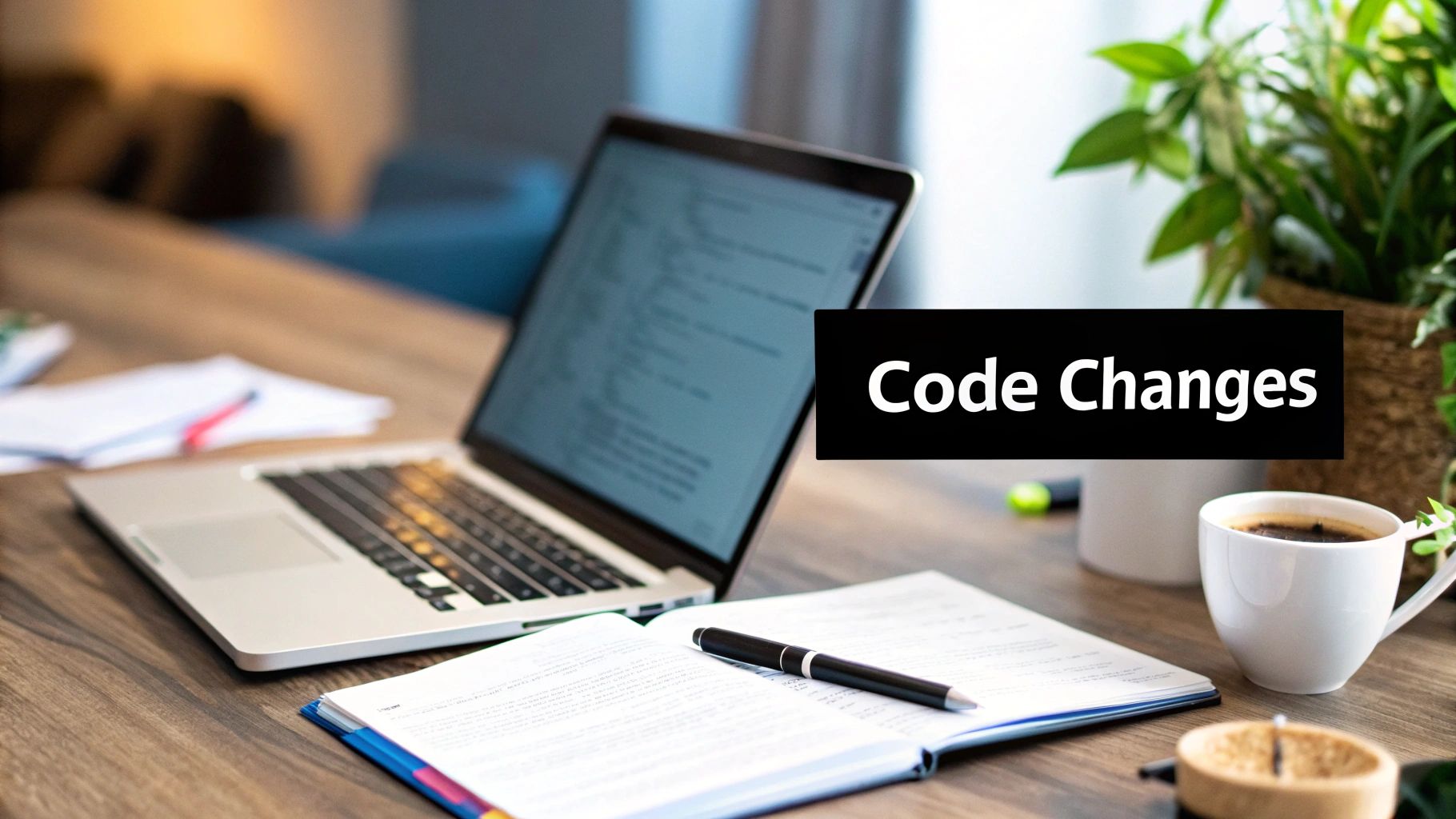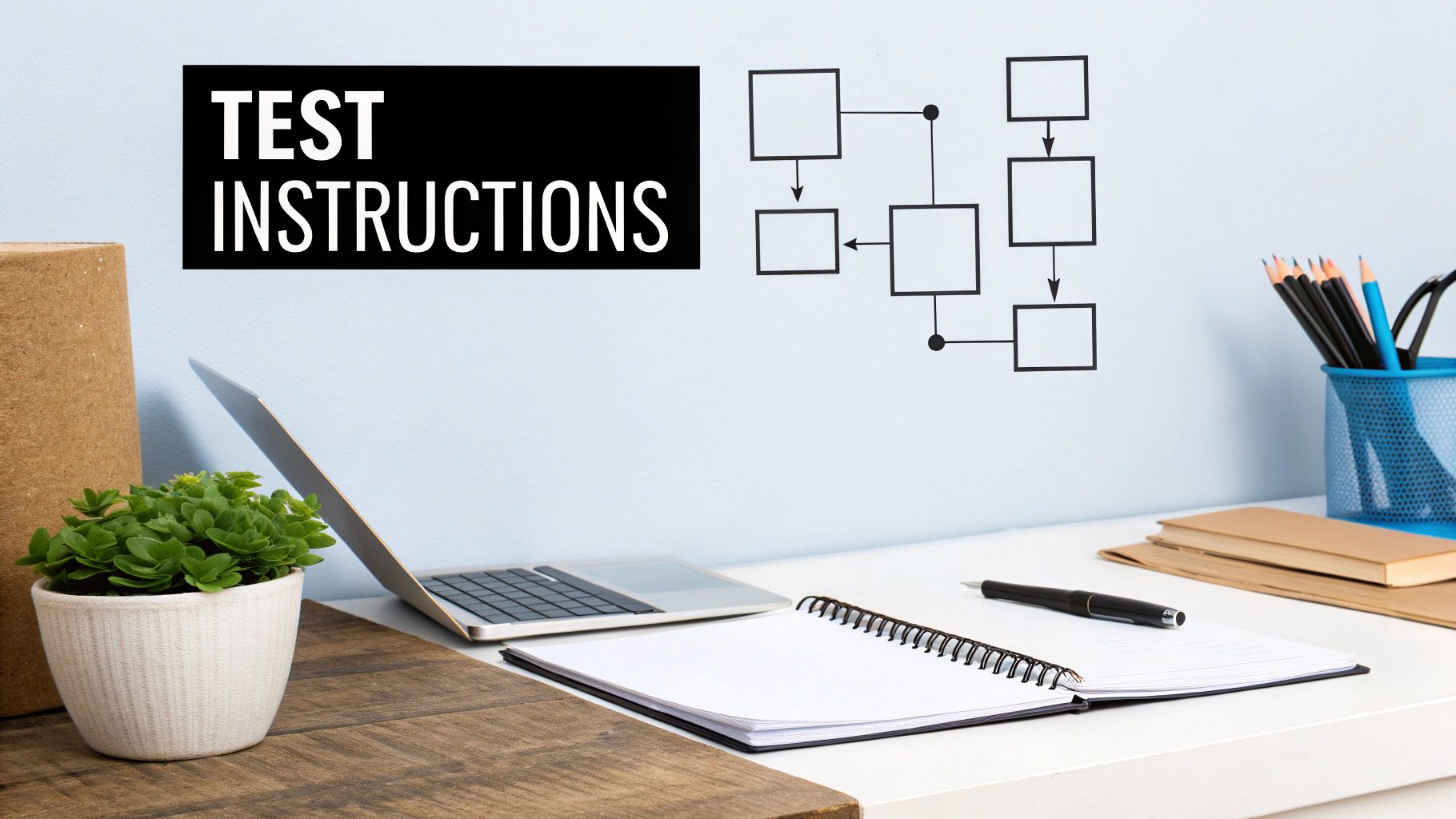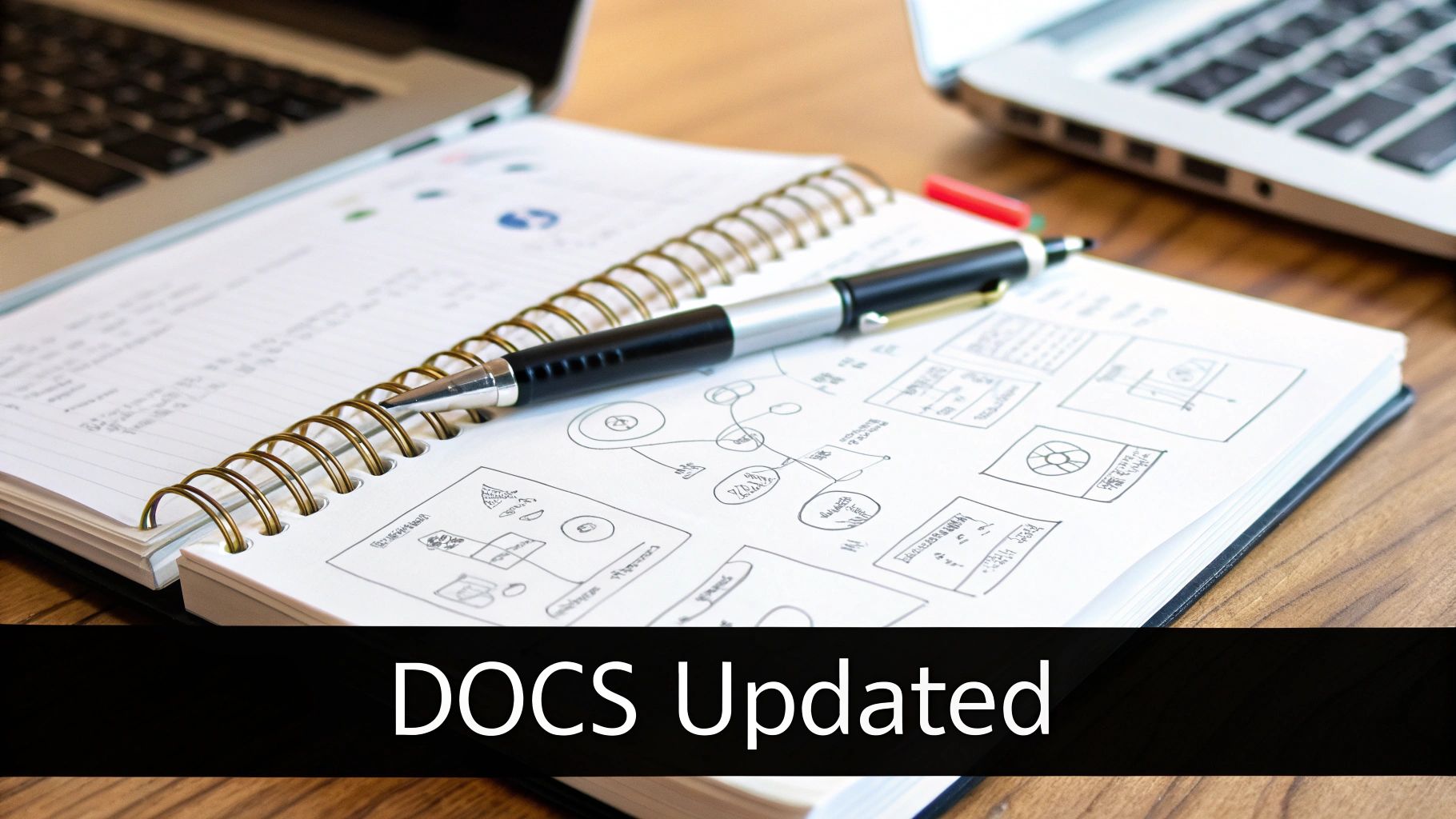GitHub Pull Request Template Checklist: Must-Haves
Level Up Your Code Reviews
Code reviews and pull requests (PRs) are essential tools that help teams maintain high-quality code and effective collaboration. Over time, PRs have grown from basic patch submissions into robust systems for reviewing and discussing code changes on platforms like GitHub and GitLab. When done well, they enable thorough review, clear communication, and shared understanding between team members.
A well-structured PR template makes a huge difference in review quality and efficiency. By providing a clear framework for every code submission, you help reviewers quickly grasp the context, evaluate changes, and give useful feedback. This shared foundation reduces friction between team members and helps maintain code quality standards.
This guide will walk through 7 key elements to include in your GitHub PR template. Whether you're a data scientist running experiments, a DevOps engineer managing infrastructure, a product manager coordinating releases, or a CS student learning the ropes - mastering these essentials will help you create PRs that are easy to review and merge. You'll learn how to transform code reviews from potential bottlenecks into smooth collaboration points that keep your projects moving forward.
1. Description of Changes
Creating an effective pull request starts with a detailed description of changes. This section helps reviewers quickly understand what modifications you're proposing and why they matter. As the first item on our GitHub pull request checklist, it guides the entire review process and helps prevent confusion.

Key Elements of a Strong Description:
- Summary of Changes: Give a high-level view of what you modified in the code - keep it simple and direct
- Purpose and Motivation: Explain why you made these changes - was it to fix a bug, add a feature, improve performance, or clean up code?
- Issue Links: Connect your PR to relevant tickets in systems like Jira or GitHub Issues to create a clear paper trail
Main Benefits:
- Quick Context: Reviewers can understand your changes immediately and focus on reviewing the actual code
- Future Reference: The description becomes a useful record explaining why certain decisions were made
- Easy Look-up: When checking old code changes later, you have clear documentation of what was done and why
Sample Descriptions:
- Added Google OAuth2 login feature to resolve issue #123 and enable user authentication
- Updated the user database schema with new required fields (first_name, last_name, birth_date) per spec v2.1
- Fixed memory leak in background task processing to address performance issues in ticket JIRA-456
Writing Better Descriptions:
- Break complex changes into clear bullet points
- Include both technical details and business reasons
- Link to specs, design docs, and other helpful resources
Clear descriptions have become essential as teams work remotely across different time zones. Good communication reduces confusion and speeds up reviews, helping everyone stay aligned.
For Product Managers tracking feature releases, Data Scientists monitoring pipeline changes, or Mobile Engineers adding new capabilities - precise descriptions help every team member understand the impact of code changes.
You might find it helpful to explore more about writing effective PR descriptions. The GitHub Docs provide excellent guidance on this topic.
Remember to link each description to relevant issues, documentation and resources that can help reviewers better understand the context of your changes. Also check out our guide on code review best practices for more tips.
2. Testing Instructions
Testing instructions are vital for efficient code reviews. By providing clear guidance on how to validate changes, you help reviewers do their job effectively and catch issues before they reach production. Good testing instructions eliminate confusion and reduce back-and-forth discussions.

Features:
- Test Environment Setup: List steps to set up the testing environment, including environment variables, dependencies, and required tools
- Test Scenarios: Outline specific scenarios for reviewers to test, covering both core functionality and edge cases
- Expected Results: Clearly describe what should happen in each test case to help reviewers verify proper behavior
Pros:
- Faster Reviews: Clear instructions let reviewers focus on giving feedback rather than figuring out testing steps
- Better Test Coverage: Step-by-step guidance helps ensure thorough testing across different scenarios
- Fewer Missed Cases: Explicitly defining test cases prevents overlooking important edge cases
Cons:
- Takes Time to Write: Creating detailed instructions requires planning, especially for complex features
- Needs Maintenance: Instructions must be updated as code changes over time
Examples:
- Run
npm install - Start server with
TEST_MODE=true - Navigate to
/users/profile - Verify new fields appear (first name, last name, and email)
- Try submitting the form with empty fields. Verify appropriate error messages are displayed.
- Try submitting the form with an invalid email format. Verify an error message is displayed.
Tips for Implementation:
- Cover All Cases: Include both happy path and edge cases to test error handling and boundary conditions
- Provide Test Data: Include sample data needed for testing or explain how to generate it
- List Requirements: Specify any tools, software, or accounts needed upfront
Good testing instructions are key for maintaining code quality as teams adopt faster release cycles and continuous integration/continuous delivery (CI/CD). By catching issues early in development through proper testing guidance, teams save time and resources. Adding testing instructions to pull request templates helps deliver reliable software consistently.
3. Type of Change
When submitting a pull request, specifying the type of change helps guide reviewers and improves collaboration. This simple step provides essential context about your changes and helps reviewers understand how to approach their evaluation.
The main categories for classifying changes include:
- Bug fix: Corrections to existing issues or defects
- New feature: Addition of new functionality
- Breaking change: Updates that modify existing APIs or behaviors
- Documentation update: Changes focused on improving or expanding documentation
To make this classification even more helpful, consider adding:
- Impact levels: Marking changes as low, medium, or high priority
- Breaking change warnings: Clear flags for changes that may affect compatibility
- Project-specific categories: Custom types like "Performance Fix" or "Security Update" that match your needs
Example Format:
[x] Bug fix [ ] New feature [ ] Breaking change [ ] Documentation update
Key Implementation Tips:
- Use clear checkboxes for easy visual selection
- Add priority levels where relevant
- Create custom categories that fit your project
- Keep the format consistent
Benefits for Code Reviews:
The type of change classification helps reviewers:
- Get immediate context about the changes
- Focus their review on relevant aspects
- Prioritize urgent changes
- Identify potential compatibility issues early
Industry Standard Practice:
This approach has become standard on platforms like GitHub, GitLab, and across the software industry. Teams have adopted it because it improves communication and helps manage complex codebases more effectively.
While simple, this classification step plays a vital role in code reviews. It helps teams provide better feedback, catch potential issues earlier, and maintain high code quality standards through clear communication about changes.
4. Dependencies and Requirements

A clear outline of dependencies and requirements in your pull request helps ensure smooth integration and deployment. This information helps team members understand exactly what's needed for your changes to work properly. From data scientists working with Python packages to DevOps engineers managing deployments, proper dependency documentation is essential for everyone involved.
Product managers and agile coaches also benefit from this visibility, as it helps with planning and risk assessment. The goal is to list all new dependencies, version updates, and system requirements introduced by your code changes.
Key elements to include in your Dependencies and Requirements section:
- Version Numbers: Always list exact versions (e.g.,
requests==2.28.1instead of justrequests) to prevent compatibility issues - External Resources: Document all external libraries, packages, APIs, and third-party services your code needs
- System Specs: List OS versions, hardware requirements, and any special software needed
- Config Changes: Note any needed modifications to configuration files, including specific settings
Real Example: For a new machine learning feature, you might list:
- scikit-learn==1.2.0
- pandas==1.5.1
- tensorflow==2.11.0
- CUDA 11.2
Package managers like pip, npm, and conda have made dependency management easier. Files like requirements.txt and package.json help teams track and install needed packages consistently.
Benefits:
- Prevents deployment problems by documenting requirements upfront
- Makes version control and rollbacks easier
- Helps other developers integrate changes smoothly
Challenges:
- Requires ongoing updates as dependencies change
- Can get complex with many interconnected packages
Best Practices:
- Use exact version numbers
- Flag any breaking changes from updates
- Include both direct and indirect dependencies
- Keep the list current and accurate
By carefully documenting dependencies and requirements, you help ensure your code changes integrate smoothly and work reliably. This documentation becomes even more valuable as projects grow in complexity.
Want to learn more about dependency management? Check out our other resources:
- Sitemap
- Articles on effective pull request workflows
5. Documentation Updates

Clear and current documentation forms the backbone of successful software projects. It acts as the source of truth for how the software works, guiding both users and developers. That's why documentation updates are essential for every pull request. While often overlooked, this step directly impacts how easily teams can maintain and use the software.
Documentation that falls behind code changes leads to confusion and wasted time for everyone involved. By making documentation updates part of the pull request process, teams ensure their project knowledge stays fresh and useful.
Key Areas to Update in Documentation:
- API Changes: Update all endpoint details, parameters, responses, and auth requirements. Tools like Swagger or JSDoc help streamline this process
- README File: Keep installation steps, usage guides, and contribution guidelines current
- Project Wiki: Refresh relevant tutorial pages, FAQs, and detailed guides
- Code Comments: Review and align comments with new code changes
- Release Notes: Document changes clearly for users and stakeholders
Documentation Checklist:
- [ ] API documentation updated
- [ ] README reflects changes
- [ ] Wiki pages revised
- [ ] Release notes prepared
Why Good Documentation Matters:
- Keeps Information Current: Prevents outdated or incorrect guidance
- Makes Maintenance Easier: Helps developers understand and modify code
- Speeds Up Onboarding: Reduces learning time for new team members
Best Practices for Documentation Updates:
- Share direct links to updated docs in your pull request
- Check all related documentation sections for needed updates
- Consider translation needs for global projects
Real Example: When a team adds required authentication to an API endpoint, updating the docs prevents hours of troubleshooting by other developers. Instead of discovering the change through trial and error, they can immediately see the new requirements.
Documentation's Growing Role: As software projects become more collaborative, clear documentation has become essential. Teams working across time zones and organizations rely on well-maintained docs to work effectively. Quality documentation is now a clear sign of a well-run project.
Including "Documentation Updates" in pull request checklists helps teams maintain this vital resource. It ensures documentation remains valuable and trustworthy throughout the project's life.
6. Security Considerations
Solid security practices are at the heart of quality software development. Poor security can lead to costly data breaches, outages, and damage to brand reputation. This is why every pull request must go through careful security evaluation before approval.
Features:
- Security Impact Analysis: Before any code changes, identify potential attack vectors and security implications. This includes reviewing for common vulnerabilities like SQL injection, cross-site scripting, and denial-of-service scenarios.
- Automated Scanning: Use security scanning tools like SAST and DAST to catch common security flaws early in development.
- Access Control Review: Check that authentication and authorization are properly implemented and tested. This covers password handling, session management, and role-based permissions.
Example Checklist Items:
- [ ] Security impact analyzed
- [ ] No exposed sensitive data (API keys, credentials, PII)
- [ ] Authentication/authorization tested
- [ ] Security scans completed and issues fixed
- [ ] Secure coding standards followed
Pros:
- Early Prevention: Catching security issues during code review prevents them from reaching production
- Standards Alignment: Helps meet security compliance requirements and best practices
- Risk Reduction: Regular security checks minimize the overall attack surface
Tips for Implementation:
- Add security scanning to your CI/CD pipeline
- Review access controls and permissions carefully
- Check thoroughly for exposed sensitive data
- Make security a focus during code reviews
- Provide ongoing security training for developers
Key Contributors:
The OWASP Foundation has been instrumental in promoting security best practices in software development. Their resources like the OWASP Top 10 outline critical web application security risks that every developer should understand.
Why This Matters:
Good security isn't optional - it's essential for protecting users and organizations. By making security reviews a core part of the pull request process, teams can catch vulnerabilities early and build stronger applications. Security awareness needs to be part of the development culture, from junior devs to engineering leaders. When everyone owns security, we create safer software.
7. Review Readiness
A final quality check before submitting your pull request (PR) can make a huge difference in how smoothly the review process goes. Just like proofreading an important document, this last review ensures your code meets project standards and makes reviewers' jobs easier. Taking time now to verify everything from code style to test coverage helps create a more productive review cycle.
Key Elements of a Review-Ready PR:
- Code Style: Make sure your code follows the project's style guide (like PEP 8 for Python). Use tools like flake8 or pylint to check automatically.
- Tests: Verify you have good test coverage and all tests pass before submitting. This prevents bugs and regressions.
- Performance: For speed-critical code, check if your changes impact performance using profiling tools.
- Merge Status: Fix any merge conflicts with the target branch before asking for review. This saves reviewers from dealing with conflict resolution.
Benefits:
- Better Quality: Pre-review checks help maintain high code standards
- Faster Reviews: Clean, well-prepared PRs get reviewed more quickly
- Fewer Revision Rounds: Catching issues early means less back-and-forth with reviewers
Potential Drawbacks:
- Takes Extra Time: These checks add some upfront work - but save time overall
- May Still Need Changes: Reviewers might request updates, but good preparation reduces major revisions
Pre-Submission Checklist:
- [ ] All tests pass
- [ ] Code matches style guide
- [ ] No merge conflicts exist
- [ ] Changes are reasonably sized
Implementation Tips:
- Run style checkers as part of your workflow
- Monitor test coverage numbers
- Keep target branch synced and resolve conflicts early
- Review your own changes carefully
- Create a personalized checklist for your project
For more detailed guidance on PR best practices, check out resources like Pull Request Checklist.
A thorough review readiness check helps everyone on the team - from developers and data scientists to engineering managers and product owners. It leads to faster delivery cycles and higher quality code. Even those teaching computer science or analyzing IT systems can apply these principles to create better code review processes.
GitHub PR Template: 7-Point Comparison
| Checklist Item | 🔄 Complexity | ⚡ Resources | 📊 Expected Outcomes | ⭐ Key Advantages | |------------------------------|--------------------------------------|----------------------------------------------|----------------------------------------------------|--------------------------------------------------------| | Description of Changes | Low (clear summary) | Minimal; quick write-up | Provides context and a documentation trail | Immediate clarity for reviewers | | Testing Instructions | Medium (step-by-step process) | Higher; requires test environment setup | Validated functionality with thorough checks | Reduces review time and identifies edge cases | | Type of Change | Very Low (checkbox based) | Minimal; selection only | Clear classification of modifications | Easy to implement and improves clarity | | Dependencies and Requirements| Medium (detailed dependency check) | Moderate; careful documentation required | Preempts deployment issues and integration risks | Simplifies integration and ensures version control | | Documentation Updates | Low-Medium (updating multiple docs) | Minimal to moderate; doc revisions necessary | Maintains accurate and current project documentation | Enhances maintainability and aids new team members | | Security Considerations | Medium-High (in-depth security review)| Higher; requires security tools and analysis | Mitigates vulnerabilities and ensures compliance | Enhances security and reduces risk | | Review Readiness | Medium (final quality check) | Moderate; includes tests and style checks | Confirms PR meets quality standards | Speeds up the review process and minimizes rework |
Ready to Elevate Your Workflow?
A solid GitHub pull request template checklist makes a real difference in your team's code review process. By focusing on these 7 core areas - from change descriptions to testing details to security checks - you help your team communicate better, catch issues early, and ship higher quality code. When everyone follows the same process, code reviews become smoother and more effective.
Start by adding these checklist items to your current pull request templates. Remember that one size doesn't fit all - customize the checklist based on what matters most for your specific team and projects. Review and update it regularly as your needs change and new best practices emerge. Keep an eye on software development trends to make sure your process stays current, especially around key areas like security and automation.
Key Benefits:
- Better Team Communication: When pull requests include all the right details, reviewers and contributors stay aligned
- Fewer Issues: A structured checklist helps catch potential problems before they reach production
- Stronger Code: Thorough reviews lead to more reliable and maintainable code
- Consistent Process: Checklists keep teams synchronized, even with new contributors or complex changes
- Room to Evolve: Regular updates ensure your checklist matches your team's changing needs
Want to make your code reviews even more effective? Pull Checklist adds automated, condition-based checklists right into your GitHub Pull Requests. Set required tasks, enforce blocking checks, and track completion to ensure nothing slips through. With customizable templates and detailed reporting, Pull Checklist helps your team maintain quality standards and consistency - even across large codebases. Start improving your team's code reviews today!
